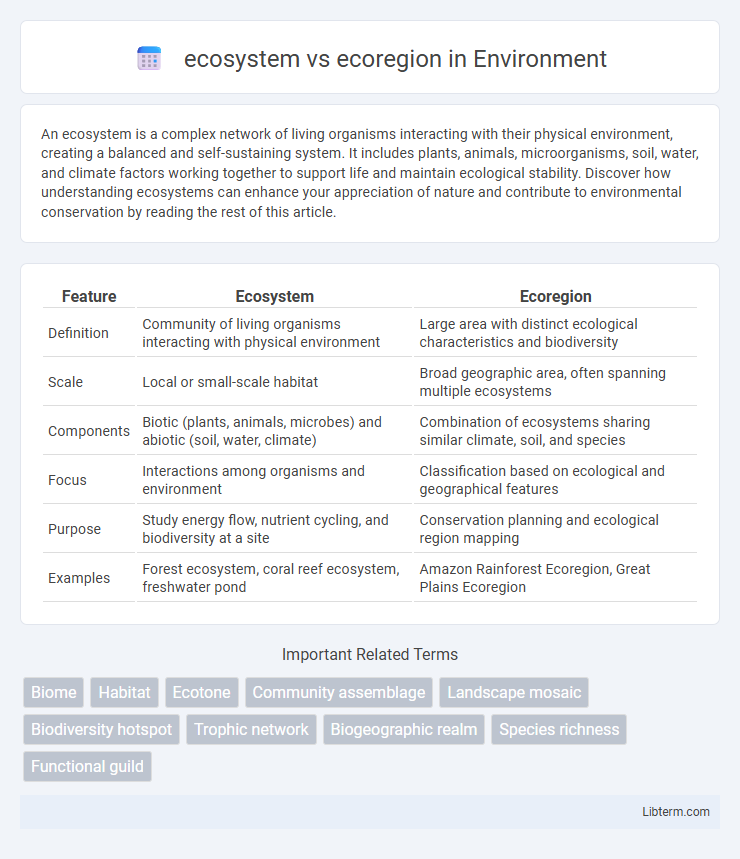An ecosystem is a complex network of living organisms interacting with their physical environment, creating a balanced and self-sustaining system. It includes plants, animals, microorganisms, soil, water, and climate factors working together to support life and maintain ecological stability. Discover how understanding ecosystems can enhance your appreciation of nature and contribute to environmental conservation by reading the rest of this article.
Table of Comparison
| Feature | Ecosystem | Ecoregion |
|---|---|---|
| Definition | Community of living organisms interacting with physical environment | Large area with distinct ecological characteristics and biodiversity |
| Scale | Local or small-scale habitat | Broad geographic area, often spanning multiple ecosystems |
| Components | Biotic (plants, animals, microbes) and abiotic (soil, water, climate) | Combination of ecosystems sharing similar climate, soil, and species |
| Focus | Interactions among organisms and environment | Classification based on ecological and geographical features |
| Purpose | Study energy flow, nutrient cycling, and biodiversity at a site | Conservation planning and ecological region mapping |
| Examples | Forest ecosystem, coral reef ecosystem, freshwater pond | Amazon Rainforest Ecoregion, Great Plains Ecoregion |
Defining Ecosystems: Key Characteristics
Ecosystems are dynamic biological communities interacting with their physical environment, characterized by energy flow, nutrient cycling, and population interactions within a specific area. They encompass biotic components, including plants, animals, and microorganisms, and abiotic factors such as soil, water, and climate. Unlike ecoregions, which are large areas defined by environmental conditions and species composition, ecosystems emphasize functional processes and relationships within localized habitats.
What is an Ecoregion?
An ecoregion is a geographically defined area characterized by a distinct combination of natural communities, climate, soil, and ecological processes that differentiate it from surrounding regions. It encompasses multiple ecosystems sharing similar environmental conditions and species assemblages, allowing for targeted conservation and management strategies. Ecoregions serve as essential frameworks for understanding biodiversity patterns and guiding sustainable land use practices.
Core Differences Between Ecosystem and Ecoregion
An ecosystem refers to a dynamic community of living organisms interacting with their physical environment within a specific area, encompassing biotic and abiotic components. An ecoregion, however, is a larger geographical unit defined by consistent ecological patterns, including climate, soil, vegetation, and topography, representing a broad area with similar ecosystems. The core difference lies in scale and scope: ecosystems focus on interactions within a localized habitat, while ecoregions classify expansive zones sharing homogeneous ecological characteristics.
Scale and Scope: How Size Matters
Ecosystems refer to localized communities of interacting organisms and their physical environment, typically covering smaller, more specific areas such as a forest patch or a pond. Ecoregions encompass larger geographic areas defined by broad patterns of climate, soil, vegetation, and biodiversity, often spanning multiple ecosystems and landscapes. The scale and scope difference influence conservation strategies, with ecosystems requiring fine-scale management and ecoregions guiding large-scale environmental planning.
Biotic and Abiotic Components Explained
Ecosystems encompass the dynamic interactions between biotic components, such as plants, animals, and microbes, and abiotic factors, including soil, water, temperature, and sunlight, shaping functional habitats. Ecoregions are geographically distinct areas characterized by specific combinations of climate, soil types, vegetation, and species, reflecting unique biotic and abiotic relationships on a broader scale. Understanding the interplay of these components helps define ecosystem processes within ecoregions, facilitating biodiversity conservation and environmental management.
Geographic Boundaries: Fixed vs. Fluid
Ecosystems are characterized by fluid geographic boundaries influenced by interactions among living organisms and their environment, leading to dynamic and often overlapping zones. By contrast, ecoregions have fixed geographic boundaries defined by consistent climatic, geological, and vegetation patterns, allowing for clearer classification and mapping. Understanding the distinction between the fluid nature of ecosystems and the fixed limits of ecoregions is crucial for environmental management and conservation planning.
Ecological Functions and Processes
Ecosystems encompass dynamic ecological functions and processes such as nutrient cycling, energy flow, and species interactions within a defined biological community and its physical environment. Ecoregions represent larger geographic areas characterized by distinct climate, soil, and vegetation patterns that influence the ecological functions and processes occurring within multiple interconnected ecosystems. Understanding these differences aids in targeted conservation efforts by linking specific ecological functions to the spatial scales at which ecoregional conditions affect biodiversity and ecosystem services.
Conservation Strategies: Ecosystems vs. Ecoregions
Conservation strategies targeting ecosystems emphasize preserving specific biological communities and their interactions, focusing on habitat restoration and species protection within defined ecological functions. Ecoregion-based conservation prioritizes broader geographic areas characterized by similar climate, soil, and biodiversity patterns, integrating regional land-use planning and large-scale habitat connectivity. Effective biodiversity preservation combines ecosystem-specific management with ecoregional approaches to address both local ecological processes and landscape-level environmental sustainability.
Examples from Around the World
The Amazon Rainforest ecosystem, characterized by dense tropical forests, exemplifies a complex community of plants, animals, and microorganisms interacting with their environment. In contrast, the Amazon Ecoregion covers a broader area that includes multiple ecosystems sharing similar climate, soil, and biodiversity traits, such as the Guiana Shield and Atlantic Forest. Other notable examples include the Great Barrier Reef ecosystem, composed of coral, fish, and marine life, within the larger Great Barrier Reef Ecoregion that spans diverse marine habitats along Australia's northeastern coast.
Importance in Environmental Management
Ecosystems represent dynamic complexes of living organisms interacting with their physical environment, essential for maintaining biodiversity and ecological processes. Ecoregions, defined as large areas characterized by distinct ecological patterns and environmental conditions, provide a spatial framework critical for regional environmental management and conservation planning. Integrating ecosystem functions within ecoregional boundaries enhances resource management, habitat protection, and climate change mitigation strategies by aligning efforts with natural ecological units.
ecosystem Infographic

 libterm.com
libterm.com